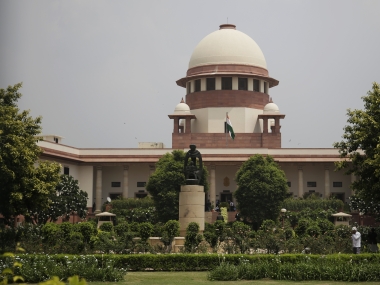By Shobhit Mathur and Pallabi Mandal New Delhi: High courts nationwide are 37 percent short of judges, and ad hoc appointments–not posting judges to courts that need them most–are worsening delays and affecting India’s economy, according to our analysis of
data released by the department of justice. There were over 4.2 million cases pending in the 24 high courts of India on 4 February, 2018, according to the
National Judicial Data Grid, with 49 percent of these cases more than five years old. Data from central ministries show that infrastructure projects of close to Rs 52,000 crore are affected by court orders, according to the
Economic Survey 2017-18. India’s judicial delays are legendary, and the shortage of judges is well documented, as IndiaSpend has previously reported (
here,
here,
here and
here). The Allahabad High Court has the highest number of pending cases, exceeding 900,000 cases in 2016 and 2017. The number of pending cases has declined during 2017 by a slight margin in only three of 24 high courts. In terms of increase in pending cases, Karnataka High Court is the most stressed court with an increase in pendency of 36,479 cases followed by Hyderabad and Punjab & Haryana with 32,548 and 30,195 pending cases, respectively. [caption id=“attachment_4346843” align=“alignleft” width=“380”] File image of Supreme Court of India. AP[/caption] The working strength of judges has not changed for the three high courts of Jharkhand, Meghalaya and Sikkim. The number of judges has declined in Calcutta (seven), Himachal Pradesh (three), Gujarat and Tripura (two) and Manipur and Orissa (one). The working strength has increased in all other courts with Madras witnessing the maximum increase of 16 judges, followed by Bombay with 10 judges, and Patna, Rajasthan, Gauhati and Chhattisgarh with six judges each. One would expect that the most stressed courts should get a good share of new judges. The simplest metric to compute the stress is the average pending cases per judge. The higher the average case burden per judge, more stressed the court.
| Workload Per High Court Judge & Corresponding Allocation Of Judges |
|---|
| Court |
| Calcutta |
| HP |
| Karnataka |
| Orissa |
| Gujarat |
| Tripura |
| Hyderabad |
| Jharkhand |
| Punjab and Haryana |
| Manipur |
Note: Click here for data on all high courts. Source: Supreme Court Annual Reports 2015-16 and 2016-17
In 2016, although Bombay had a lower workload per judge than Calcutta, Bombay saw an increase of 10 judges while Calcutta saw a decline of seven judges. Rajasthan and Gauhati got the same increase in judges while Rajasthan had twice the workload per judge than Gauhati. Madras and Bombay have got disproportionally high allocation of judges, while Allahabad, Hyderabad, Karnataka and Jammu & Kashmir have lower allocation despite high caseloads. New judges should be allotted–or transfers made–to courts depending on pending cases. And the judicial appointments and transfers should be based on the metric of workload per judge.
Currently, the collegium (which comprises of the Chief Justice of India and four senior most judges of the Supreme Court) recommends the appointments and transfers of judges. The collegium does not have any place in the Constitution. The government had recommended the National Judicial Appointments Commission (NJAC) as a constitutional body to replace the collegium system of appointments of judges. However, the Supreme Court rejected the NJAC Act. “Given the high pendency of cases and high vacancy in the Allahabad High Court, transparency in the allocation of judges is very important,” said Vinod Kumar Singh, senior advocate, High Court of Allahabad (Lucknow bench). “I hope the collegium makes the allocation process more transparent.” “But for the system to heal, the process of higher judicial appointments needs a fundamental rejig,” Member of Parliament Baijayant ‘Jay’ Panda, wrote in The Times of India on 18 January, 2018. “SC would do well to review its NJAC decision; if it does not, Parliament must re-enact something similar.” The article was first published in IndiaSpend.


)

)
)
)
)
)
)
)
)



